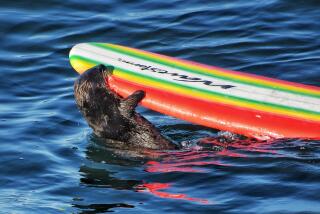Sea Otter Rescued From Alaskan Oil Spill Gives Birth
- Share via
SAN DIEGO — An Alaskan sea otter that survived the Exxon Valdez oil spill has given birth at Sea World to an apparently healthy pup, and scientists at the marine park say they are optimistic that the four-pound fur ball will continue to flourish.
Brownie, one of six Valdez survivors that make their home in a 50-foot Sea World exhibition pool, was discovered to be in labor on Monday at 5:10 p.m., just minutes after the park closed. At about 5:15 p.m., Brownie turned a series of underwater somersaults and surfaced with a baby clutched to her chest.
“From the way she’s handling the pup, I would guess she’s an experienced mother,” said Tom Goff, the park’s marine mammal curator, as he watched Brownie on Tuesday grooming, fluffing and drying the baby resting on her chest. As a precautionary measure, the park shut down the otter exhibit indefinitely, to spare the infant the noise of the crowds. But soon, Goff said, the unnamed baby likely will be on display.
Sea World scientists are heartened by the new arrival, which they say may provide new insights into the long-term effects of crude-oil poisoning. If nothing else, they said, the fact that Brownie could conceive a baby indicates a significant recovery.
“It’s certainly cause to be pleased,” said Don Kent, executive director of the park’s research institute, which is working with the U.S. Fish and Wildlife Service on a study of the otters.
“The vitality of the (baby) will be watched very carefully. To make an analogy: What’s the thriving capability of babies that are born to drug-addicted parents? There’s a chemical effect at an embryonic age. What long-term effect does that have? Hopefully, none in this case. But we don’t know,” Kent said.
Goff pointed out that the birth may bode well for the 300 Alaskan sea otters that were rescued from the shores off Bligh Reef in Prince William Sound, rehabilitated and returned to the wild.
“It might be a clue that they’ll be able to reproduce,” he said, looking through a plate-glass window at the floating mother and child. “In her case at least, it looks like that question has been answered.”
When Brownie arrived at Sea World last August, the otter’s thick fur was still matted with the gooey crude oil that had spilled from the damaged tanker. More life-threatening than her soiled pelt, however, were the otter’s efforts to clean it. To maintain buoyancy and warmth, otters continually lick and groom their coats, and Brownie, like many otters caught in the worst spill in U.S. history, had ingested potentially fatal amounts of oil.
Luckily for her, the spill prompted park scientists to come up with an emergency antidote: powdered charcoal that absorbed the toxins and saved the otters’ lives.
More to Read
Sign up for Essential California
The most important California stories and recommendations in your inbox every morning.
You may occasionally receive promotional content from the Los Angeles Times.













